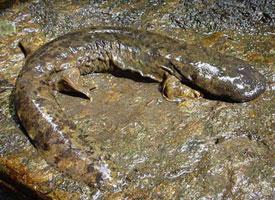
Popis zvířete
The Japanese giant salamander (Andrias japonicus) is a remarkable and enigmatic creature that dwells in the freshwater rivers of Japan. As one of the largest amphibians in the world, it can reach lengths of up to 1.5 meters (almost 5 feet), though most individuals are smaller. This ancient species, which has existed for millions of years, plays a significant role in both the biodiversity of its habitat and in Japanese culture and folklore.Physical Description:
The Japanese giant salamander has a distinctive and somewhat prehistoric appearance, characterized by its large, bulky body, wide, flat head, and small eyes positioned on top of its head, which are adapted for its nocturnal and aquatic lifestyle. Its skin is wrinkled and mottled, usually in shades of brown and black, allowing it to blend seamlessly with the rocky riverbeds it calls home. Unlike many other amphibians, the Japanese giant salamander has very tiny, rudimentary eyes, and relies heavily on other senses, particularly its highly developed sense of touch, to navigate and hunt in the dark waters.
Habitat and Distribution:
This amphibian is endemic to Japan, found primarily in cool, fast-flowing streams and rivers throughout the islands of Honshu, Kyushu, and Shikoku. It prefers clean, oxygen-rich water, which is essential for its survival, making it a key indicator species for the health of its freshwater habitat.
Behavior and Ecology:
The Japanese giant salamander is nocturnal, spending most of the day hidden under rocks or in crevices, emerging at night to feed. Its diet is carnivorous, consisting mainly of fish, insects, smaller amphibians, and crustaceans. It has a unique hunting method, relying on its sensitive skin to detect vibrations in the water made by potential prey, which it then quickly snaps up with its wide, gaping mouth.
Reproduction and Lifespan:
Breeding occurs in late summer, with males establishing and defending nesting sites in burrows along the riverbanks. Females lay their eggs in these nests, and the males then guard them until they hatch, demonstrating a rare example of parental care among amphibians. The larvae are fully aquatic and undergo a long developmental period before reaching adulthood. The Japanese giant salamander can live for many decades, with some individuals reported to be over 100 years old.
Conservation Status:
The Japanese giant salamander is classified as Near Threatened by the International Union for Conservation of Nature (IUCN), primarily due to habitat loss, pollution, and the construction of dams, which disrupt its natural riverine environment. Additionally, its slow breeding rate makes it particularly vulnerable to these threats. Conservation efforts are underway in Japan to protect this unique species, including habitat restoration and captive breeding programs.
Cultural Significance:
In Japanese culture, the giant salamander is often regarded with a mix of awe and reverence, featuring in various myths and legends. It is sometimes referred to as ōsanshōuo (大山椒魚), which translates to "giant pepper fish," a name derived from the peppery secretion it produces when threatened. The species is also a popular attraction in zoos and aquariums, where it serves as an ambassador for freshwater conservation efforts.
In conclusion, the Japanese giant salamander is a fascinating and ancient creature, embodying the mysteries of the natural world. Its survival is a testament to the resilience of life, but it also highlights the delicate balance required to maintain biodiversity in our increasingly threatened global ecosystem.
Nové fotografie zvířat
Top 10 zvířat
- Chinese water dragon (Physignathus cocincinus)
- Galápagos tortoise (Geochelone nigra complex)
- Dolphin gull (Leucophaeus scoresbii)
- Japanese macaque (Macaca fuscata)
- Colombian red howler (Alouatta seniculus)
- Sea urchins (Echinoidea)
- Moustached guenon (Cercopithecus cephus)
- Diana monkey (Cercopithecus diana)
- Colossal squid (Mesonychoteuthis hamiltoni)
- Common house mosquito (Culex pipiens)